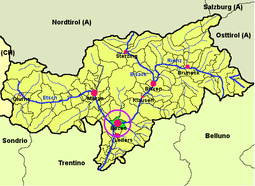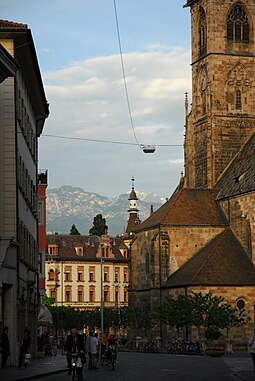| Revision as of 18:39, 21 September 2006 editSupparluca (talk | contribs)5,455 editsmNo edit summary← Previous edit | Revision as of 20:57, 21 September 2006 edit undoGryffindor (talk | contribs)Autopatrolled, Extended confirmed users53,969 editsm Reverted edits by Supparluca (talk) to last version by GryffindorNext edit → | ||
| Line 20: | Line 20: | ||
| day = | | day = | | ||
| mayor = Luigi Spagnoli| | mayor = Luigi Spagnoli| | ||
| website = | | website = | | ||
| }} | }} | ||
| ] | ] | ||
Revision as of 20:57, 21 September 2006
| The neutrality of this article is disputed. Relevant discussion may be found on the talk page. Please do not remove this message until conditions to do so are met. (Learn how and when to remove this message) |
- For other uses of Bolzano, including the mathematician Bernard Bolzano, see Bolzano (disambiguation).
| Comune di {{{name}}} | |
|---|---|
| Comune | |
| Location of {{{name}}} | |
  | |
| Coordinates: 46°30′N 11°21′E / 46.500°N 11.350°E / 46.500; 11.350 | |
| Country | Italy |
| Region | Trentino-South Tyrol |
| Province | South Tyrol (BZ) |
| Government | |
| • Mayor | Luigi Spagnoli |
| Area | |
| • Total | 52.29 km (20.19 sq mi) |
| Population | |
| • Total | 107,317 |
| Demonym(s) | German: Bozner (dialect: Boazner), Italian: Bolzanini |
| Time zone | UTC+1 (CET) |
| • Summer (DST) | UTC+2 (CEST) |
| Postal code | 39100 |
| Dialing code | 0471 |
| Website | www.gemeinde.bozen.it |

Bozen (German) or Bolzano (Italian) is a city in the Trentino-South Tyrol region of Italy. It is the capital of the autonomous province of South Tyrol (German Südtirol, Italian Alto Adige).
The South Tyrol Museum of Archeology in Bozen-Bolzano is where the ice-mummy "Ötzi" is kept.
The city is also the home of the Italian Army's Alpini High Command- COMALP and some of its combat and support units.
History
Initially inhabited by the Rhaetians, the area was settled by the Romans in 15 BCE, by general Nero Claudius Drusus, who gave the original town its Roman name, Pons Drusi. The city name later became Bauzanum. Bozen-Bolzano has been a trading point since its foundation and elevation to a city over 800 years ago, due to its location in between the two major cities of Venice and Augsburg. Four times a year a market was held and traders came from the south and the north. The mercantile magistrate was therefore founded in 1635. Every market season two German and Italian officers (appointed from the traders who operated there) worked in this office. The city was a cultural crosspoint at that time.
In 1918, at the end of World War I the Trentino also known as the Welsch-Tirol or Italian Tyrol, and the southern part of German-speaking Tyrol with its main city Bozen were occupied by Italian Army and thereafter annexed. The region was assigned to Italy according to the Treaty of London of 1915, that give to Italy all the territories included in the Italian Region (as definded by Alpine water divide), regardless of the ethnic population.
After the raising of fascism, starting from 1926, ethnic Germans were subjected to a policy of Italianisation. That involved the use of the Italian as unique official language. German schools were closed, Italian-only toponyms were imposed, many person names were translated (i.e. Franz became Franco); in some cases also family names were Italianized (i.e. Gruber became Della Fossa; Perathoner became Pietrantoni). Many ethnic Italians moved to the city from other parts of Italy (primarily from northern Italy) Indigenous South Tyroleans turned inward and thanks to the local clergy preserved their cultural identity by organizing secret German schools (so-called Katakombenschule or catacomb schools).


After 1938, as a consquence of the approaching of Nazist Germany to Fascist Italy, an agreement was reached to "solve" the problem. Nazi Germany accepted to host in the Reich of all those South Tyroleans who refused the assimilation. Local Fascists expected the elites to go and the bulk of the population to stay. However, they miscalculated and allowed Nazi agents to infiltrate the South Tyrol who pushed the indigenous the population to opt for emmigration in large numbers. The majority of the inhabitants who spoke German and Ladin had to choose between moving to Germany or assimilation (the so-called Opzione or "Option"). Almost 80 per cent chose to go to Germany. Nazis officials meanwhile planned to resettle ethnic south Tyroleans in German-occupied territories such as Luxembourg or Crimea. However, when Fascism collapsed in 1943, emigration came to a standstill. This period was very traumatic for the German-speaking population, and rivalries and tensions emerged between those who had chosen emigration to Germany (the Optanten) and those who had stayed (the Dableiber). Altogether only a third of the 75,000 who actually made the trek northward came back after 1945.
Society and economy
After World War II Italy, then led by Prime Minister Alcide De Gasperi (a Trentino native and a former member of the Reichsrat Parliament in Vienna before 1914) and Austrian Chancellor Gruber signed an agreement that would have guaranteed the province a substantial degree of autonomy. However, Bozen-Bolzano was incorportad in the larger Trentino-South Tyrol region that had an overall Italian-speaking majority. However, the implementation of the UN-brokered treaty between Italy and Austria fell short of local expectations. Ethnic tensions resurfaced, culminating in a wave of bombings and acts of sabotage during the 1960s by South Tyrolean activists. Apparently some cooperated with neo-Nazi groups in Austria and Germany. Only after a new autonomy package was negotiated in 1969-1972 and the province of Bozen-Bolzano was given a greater autonomy from the Italian central government, did ethnic clashes subside. The autonomy package took 20 years before it was fully implemented. This, and the determined defense of their culture and language, has allowed the German speaking population to avoid assimilation. Instead, Italian-speaking Alto Atesini or Upper Atesins began complaining of discrimination.
As part of the autonomy package, the province of South Tyrol became autonomous and German, Italian and Ladin became official languages. The city changed its official name to Bozen-Bolzano in order to reflect the multicultural status. Other towns and villages throughout South Tyrol also received double-names.

According to the 2001 census, 73% of the city inhabitants were Italian speakers. Of the remainder, 23% speak German and 1% Ladin as their first language. Outside of the city Bozen-Bolzano the majority of inhabitants speak German as first language (according to 2001 census, there are approx. 330,000 German-speaking South Tyroleans among 475,000 inhabitants of South Tyrol). There are many bilingual people. A small minority of people speak Ladin.
South Tyrolean society is still to some extent segmented across ethnic lines. Because of its special autonomy and the unique industrious and collaborative culture, Bozen-Bolzano is one of the richest cities in Italy. It enjoyes a very high standard of living, ranking consistently among the top cities nationwide. See the article on South Tyrol for more information.
The city thrives on a mix of old and new—high-quality intensive agriculture (including wine, fruit and dairy products), tourism, traditional handicraft (wood, ceramics) and advanced services. Heavy industry (machinery, automotive, steel) installed during the 1930's has now been mostly dismanteled. On the downside, the local economy is very dependent on the public sector, and especially the autonomous province government.


Main sights
| This section needs expansion. You can help by adding to it. |
The city's Austrian character, enhanced by the narrow cobblestone streets, Austrian-style churches and pervasive bilingual signage give it the unique flavour of a city at crossroads between Italian and Austrian cultures. This, and its natural and cultural attractions make it a renowned tourist destination.
Among the major monuments and sights are:
- Walther von der Vogelweide Platz, with a statue of the minstrel with the same name (Minnesänger in German);
- the Archeological Museum, which hosts the Ötzi mummy;
- the Gothic Cathedral, started in 1184, probably on the foundations of a Roman villa and rebuilt in the 14th Century by architects Martin and Peter Schiche (completed 1382);
- various castles, including Schloss Maretsch, Schloss Runkelstein and Sigmundskron;
- the First World War Victory Monument, a controversial monument built by Mussolini in 1928.
- the Messner Mountain Museum Firmian
For more historical and geographical information, see South Tyrol.
City districts and neighboring communities
City districts:
- Zentrum-Bozner Boden-Rentsch / Centro-Piani-Rencio
- Oberau-Haslach / Oltrisarco-Aslago
- Europa-Neustift / Europa-Novacella
- Don Bosco
- Gries-Quirein / Gries-San Quirino
Neighbouring communities are: Eppan-Appiano, Karneid-Cornedo, Leifers-Laives, Deutschnofen-Nova Ponente, Ritten-Renon, Jenesien-San Genesio, Terlan-Terlano, Pfatten-Vadena
Other important nearby towns are Brixen-Bressanone, Bruneck-Brunico and Meran-Merano.
Twin cities
Transportation
Highway A22-E45 to Trento and Verona and to Innsbruck and Munich. Railway (main line between Italy and Germany).
Sport
- Fussball Club Südtirol-Alto Adige plays in Serie C2
- Football Club Bolzano Bozen 1996 plays in Serie D
See also
External links
- "Superficie di Comuni Province e Regioni italiane al 9 ottobre 2011". Italian National Institute of Statistics. Retrieved 16 March 2019.
- "Popolazione Residente al 1° Gennaio 2018". Italian National Institute of Statistics. Retrieved 16 March 2019.
